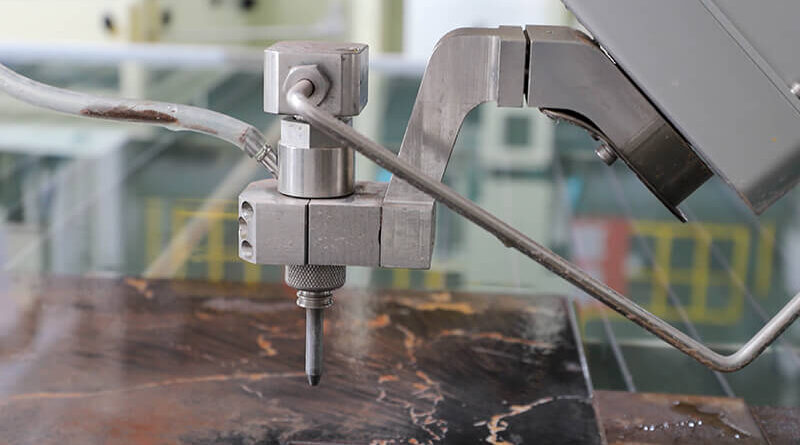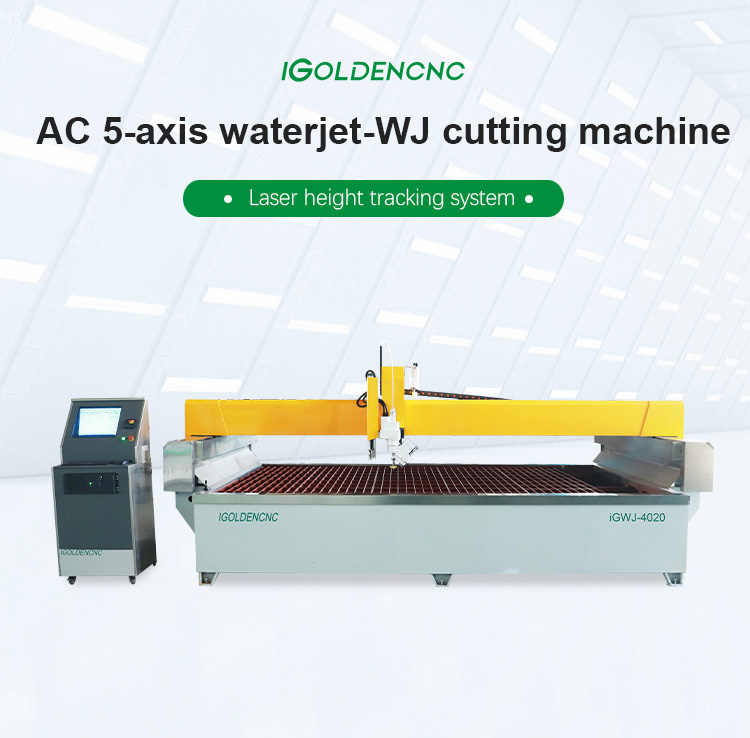Water Jet Cutting Machine to Cut Marble, Stone and Steel
A water jet cutting machine is a powerful tool used for cutting various materials, including marble, stone, and steel. It utilizes a high-pressure jet of water mixed with abrasive particles to achieve precise cuts without generating heat, making it ideal for sensitive materials.
What Is Water Jet Cutting?
Water jet cutting is a highly versatile and precise method of cutting materials using a high-pressure stream of water.

When cutting harder materials, this water stream is typically mixed with an abrasive substance, such as garnet, to increase its cutting power. The machine can cut through nearly any material without producing heat, which eliminates heat-affected zones (HAZ) that could damage delicate materials.
This method of cutting has found widespread use across industries like aerospace, automotive, construction, and sculpture, due to its precision and ability to cut through a variety of materials like metal, glass, stone, ceramics, and plastics.
Water Jet Cutting Machine Key Features
- High Precision:
- Capable of cutting intricate designs and achieving tight tolerances, ideal for detailed work in stone and metal.
- Versatility:
- Can cut a variety of materials, including marble, granite, steel, aluminum, and composite materials.
- Cold Cutting Process:
- The water jet cutting method does not produce heat, minimizing thermal damage and distortion to the material.
- Environmentally Friendly:
- Uses water as the primary cutting medium, reducing the need for harmful chemicals and generating minimal waste.
- Customization:
- Programmable CNC systems allow for complex shapes and patterns to be cut with ease.
- Multi-Axis Cutting:
- Many machines offer 5-axis cutting capabilities, allowing for the creation of three-dimensional shapes and bevels.

How Does a Water Jet Machine Cut Steel and Marble?
Cutting Steel with Water Jet Machines:
Steel is one of the most common materials cut with water jet machines. Steel comes in many forms, including mild steel, stainless steel, and tool steel, each of which has different hardness levels and thicknesses. The cutting process can be broken down as follows:
-
Pressure and Abrasive Use: Water jet machines cut steel using ultra-high pressure water, often exceeding 90,000 PSI (pounds per square inch). When an abrasive material like garnet is added, the water jet becomes a highly effective tool for cutting through steel. The abrasive particles enhance the cutting power of the water stream, allowing it to slice through hard steel with precision.
-
Material Thickness: The thickness of the steel will directly affect the cutting time and pressure. For thinner steel (under 1/4 inch), water jets can cut very quickly, with minimal pressure and fewer passes. For thicker steel, the cutting process will take longer, requiring more pressure and multiple passes to achieve a clean cut.
-
Heat-Free Cutting: A significant advantage of water jet cutting over other methods like laser or plasma cutting is that there is no heat involved in the process. This means that steel retains its mechanical properties, such as strength and hardness, without any warping or distortion that could result from heat-based methods.

Cutting Marble with Water Jet Machines:
Marble is a natural stone known for its beauty and durability. It’s widely used in construction, art, and sculpture, but it’s also more delicate than steel. Here’s how water jet cutting is applied to marble:
-
Pressure Considerations: Since marble is softer than steel, the cutting pressure is typically set lower to avoid cracking or damaging the material. However, high pressure is still essential for clean, precise cuts, especially when dealing with thicker marble slabs.
-
Abrasive Use: When cutting marble, an abrasive material is typically used, though not as much as with steel. The abrasive helps to improve the cutting efficiency, but too much abrasive can lead to unnecessary wear on the nozzle or cause cracks in the stone. Some water jet machines can even cut marble with pure water (no abrasive) depending on the thickness, but this is usually slower.
-
No Heat Damage: Like steel, water jet cutting marble has the advantage of generating no heat. This means that the marble will not experience thermal stresses, which are especially important when cutting intricate or delicate designs in marble that could crack under heat.
What Are the Key Differences When Cutting Marble and Steel with a Water Jet?
While water jet cutting works for both steel and marble, there are several important differences you must keep in mind:
1. Material Hardness:
-
Steel: Steel is much harder than marble, which requires higher cutting pressures and abrasive materials to achieve a clean cut.
-
Marble: Since marble is softer, the pressure required is lower. However, marble is more fragile and can crack easily if the pressure is too high.
2. Cutting Speed:
-
Steel: Cutting steel tends to take longer, especially with thicker pieces, due to the material’s hardness. More passes and slower speeds are often required.
-
Marble: Marble is quicker to cut, though care must be taken to adjust the pressure and abrasive mix to prevent breakage.
3. Abrasive Material:
-
Steel: A high amount of abrasive material is used to increase the cutting power.
-
Marble: Less abrasive is used, as too much can cause cracking or over-abrasion of the material.
4. Cost of Operation:
-
Steel: Cutting steel requires high pressure and abrasive material, both of which contribute to higher operational costs.
-
Marble: Although cutting marble requires less abrasive, the precision needed still makes the operation more expensive than other cutting methods like traditional saw cutting.
Best Practices When Cutting Both Steel and Marble with Water Jet Machines
1. Material Thickness:
-
Always assess the thickness of the material before starting the cutting process. Thicker materials, like 1-inch steel or 2-inch marble, will require slower speeds, more abrasive, and higher pressures.
2. Adjusting Water Jet Settings:
-
Fine-tuning the water jet’s pressure and speed settings based on the material’s thickness and hardness is crucial. For steel, the water pressure should be higher, while for marble, pressure should be adjusted to avoid causing cracks.
3. Experienced Operators:
-
Operators must have a deep understanding of the materials being cut. Cutting steel and marble requires knowledge of how to adjust the water jet settings and how to properly select the abrasive material.
4. Regular Maintenance:
-
Regularly check the machine’s components, including the nozzle, abrasive delivery system, and pressure pumps. Routine maintenance ensures the longevity and precision of the machine.
The Advantages of Using Water Jet Machines for Steel and Marble
1. Precision and Versatility:
Water jet machines offer unmatched precision, which is crucial when cutting intricate designs, especially in marble. Their versatility allows them to handle a wide range of materials with minimal adjustments.
2. No Heat-Affected Zones:
Both steel and marble can suffer from warping, discoloration, or cracking when subjected to high heat. Water jet cutting solves this issue by eliminating heat entirely during the process.
3. Minimal Waste:
Water jet cutting is highly efficient, leaving minimal waste behind. The ability to create intricate cuts reduces the amount of material wasted, making it an eco-friendly option.
Conclusion
Water jet cutting machines are invaluable in industries requiring precision cutting of materials like marble, stone, and steel. Their versatility, precision, and eco-friendliness make them a popular choice for both industrial and artistic applications. When considering a water jet cutting machine, it’s essential to evaluate your specific needs, including the types of materials you will be cutting and the complexity of designs required.






Leave a Reply
You must be logged in to post a comment.